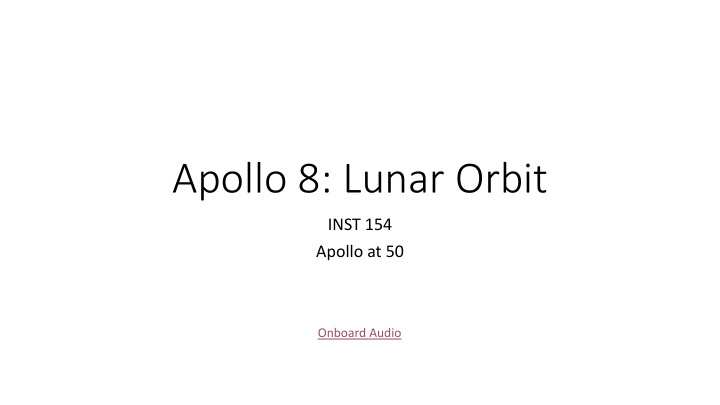



Apollo 8: Lunar Orbit INST 154 Apollo at 50 Onboard Audio
Apollo Mission Sequence As Planned As Flown • A • A Uncrewed Saturn V Apollo 4, 6 • B • B Uncrewed LM Apollo 5 • C • C CSM Earth Orbit Apollo 7 • D • C’ CSM/LM Earth Orbit Apollo 8 • E • D CSM/LM higher Earth Orbit Apollo 9 • F • F CSM/LM Lunar Orbit Apollo 10 • G • G Lunar Landing Apollo 11
Astronaut Math in mid-1967 • 30 astronauts in first 3 (of 5) astronaut groups • The Original 7, The New 9, The 14 • 10 of 30 were no longer available • 2 grounded, 2 retired, 6 dead (3 in the Apollo 1 fire, 3 in airplane crashes) • 18 of 20 were needed to fill 6 crews • Cooper and Bean were not assigned • 13 of 18 had flight experience • 6 of 9 Gemini commanders assigned as Apollo CDR • 5 of 7 assigned as Apollo CMP (4 with rendezvous experience) • 2 assigned as Apollo LMP • 5 rookies were therefore needed • 1 assigned as CMP (Eisele), 4 assigned as LMP
Apol pollo Cr Crew Planning Apollo 7 (C) Apollo 8 (D) Apollo 9 (E) CDR: Schirra CDR: McDivitt CDR: Borman CMP: Eisele CMP: Scott CMP: Collins LMP: Cunningham LMP: Schweickart LMP: Anders Apollo 10 (F) Apollo 11 (G) Apollo 12 (H) CDR: Stafford CDR: Conrad CDR: Armstrong CMP: Young CMP: Gordon CMP: Lovell LMP: Cernan LMP: Williams LMP: Aldrin Bean Haise
Arguments in Favor of a Lunar Orbit Mission • Provide valuable operational experience … This will enhance the probability of success of subsequent more complex lunar missions • Provide an opportunity to evaluate … MSFN and onboard navigation … • Permit validation of communications … at lunar distance • … improve consumables requirements prediction … • … verification of ground support elements and the onboard computer program • Increase the depth of understanding of thermal conditions … • Confirm astronauts’ ability to see, use and photograph lunar landmarks … • … an opportunity for additional photographs … for training crewmen …
Arguments Against a Lunar Orbit Mission • Marginal design conditions in the Block II CSM may not have been uncovered with only one manned flight • The life of the crew depends on the successful operation of the Service Propulsion System during the Transearth Injection maneuver • The three days endurance level required of backup systems in the event of an abort is greater than from an Earth orbit mission • Only landmark sightings and lunar navigation require a lunar mission …
Missing Redundancy • No “LM Lifeboat” for consumables or communication between TLI and TEI • No option for LM DPS TEI in the event of an SPS failure during LOI
Primary Mission Objectives • Demonstrate crew/space vehicle/mission support facilities performance during a manned Saturn V mission with CSM • Demonstrate performance of nominal and selected backup Lunar Orbit Rendezvous (LOR) mission activities, including: Trans-Lunar Injection; CSM navigation, communications, and midcourse corrections; CSM consumables assessment, and passive thermal control
Lunar Orbit Insertion
Purpose: The PAD is intended for the burn that will return the Apollo 8 crew to Earth at the end of Rev 10. Systems: The burn will be made using the SPS engine, under the control of the Guidance and Navigation system. CSM Weight (Noun 47): 45,597 pounds. Pitch and yaw trim (Noun 48): -0.40° and +1.57°. Time of ignition (Noun 33): 89 hours, 19 minutes, 15.67 seconds. Change in velocity (Noun 81), fps: x, +3,518.6; y, -151.2; z, -52.0. Spacecraft attitude: Roll, 180°; Pitch, 7°; Yaw, 0°. Expected apogee of resulting orbit (Noun 44): Not applicable. Expected perigee of resulting orbit (Noun 44): 18.6 nautical miles (34.4 km). Delta-V T : 3,522.3 fps (1,073.6 m/s). Burn duration or burn time: 3 minutes, 18 seconds. Delta-V C : 3,501.8 fps. Sextant star: Star 42 (Peacock, or Alpha Pavonis) Boresight star: Dschubba, or Delta Scorpii. COAS Pitch Angle: Down 6.9°. COAS X Position Angle: Left 4.5°. Expected splashdown point (Noun 61): 7.48° north, 165° west Range to go at the 0.05 g event: 1,299.4 nautical miles. Expected velocity at the 0.05 g event: 36,300 fps. Predicted GET of 0.05 g event: 146 hours, 50 minutes and 5 seconds GET.
Anomalies 1. Preflight: Contamination of spacecraft LOX 2. Launch: S1C camera malfunction 3. Launch: Intermittent operation of S-II power supplies 4. Launch: SII engine oscillations 5. Translunar: Drop in chamber pressure during first SPS burn 6. Throughout: Hatch and side windows obscured 7. Throughout: Obscuration of telescope field of view 8. Throughout: Abnormal shifts in computer readout of optics trunnion angle 9. Throughout: Noisy cabin fans 10. Throughout: Inoperative personal radiation dosimeter 11. Transearth: Erratic potable water quantity measurement 12. Reentry: Entry monitor system malfunctions 13. Landing: Seawater inflow through cabin pressure relief valve 14. Recovery: Inoperative swimmer’s interphone 15. Recovery: Failure of CM recovery loop
Discussion Groups • Chaikin Chapter 3 (“First Around the Moon”) • Apollo 8 from the Astronaut’s perspective • Woods Chapter 15 (“Re-entry”) • Reentry into the Earth’s atmosphere from a lunar trajectory • Kluger Chapter 7 • How the lunar orbit decision was made • From the Earth to the Moon video episode 4 (“1968”) • An interleaved telling of the story of 1968’s social unrest and Apollo 8
Apollo 10 Readings • Chaikin Chapter 4: “Before This Decade is Out” • The astronaut’s view of Apollo 9 and Apollo 10 • Cox Chapter 23: “It Was Darn Scary” • The engineer’s view of Apollo 10 • Merritt: “Review of Apollo Test Objectives Remaining After Mission D” • Why fly Apollo 10? • “The Charming Genius of the Apollo Guidance Computer” video • How the onboard navigation was done
Recommend
More recommend